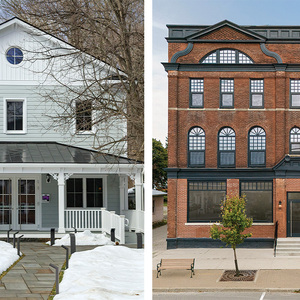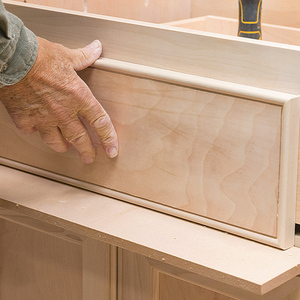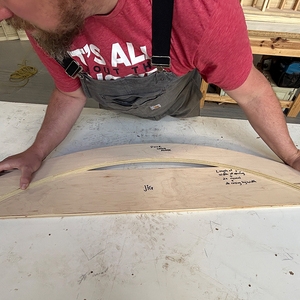hello all, first time posting to forum. i have a beautiful 1920s farm house without a lick of insulation in the exterior walls. it’s may 18th and 39 degrees here in seattle! i’m a journeyman carpenter of twenty years doing commercial remodeling so the question i have is directed to those that specialize in the residental world. what is the buzz about blow in insulation. i have heard that over time the insulation begins to settle to the bottom of the stud bays even if you layer the product in multiple lifts in the wall. has this been the case in anybodys experience? is it better to blow it in from the outside and penetrate the siding or do it from the inside and have drywall repair to patch the small holes? i know of the plugs for the exterior holes but they’re ugly and i question the weather tightness of glueing a plug on the wall. also are there any moisture/vapor barrier considerations?
any ideas would help
thanks…..bjr



















Replies
I like blown-in cellulose over other insulation. First it has the ability to fill every nook and cranny well, so well that any opening to the outside will be discovered with overflow.
Also and very important on a retrofit in particular, it serves as an air infiltration barrier, but still breathes. Cells has the abilty to migrate moisture, to spread it out over a greater area which allows the moisture to dry out. (though this becomes more problematic with a plywood sheathing or other impermeable exterior)
If blown in correctly, settlement can be kept to non existent or at least very minimal. To achieve this one must blow the cavitys in sections; I do three or four sections per 8 foot wall heigth.
Obviously blowing a wall area that is already closed n is going to be difficult to achieve 100%, but that will hold true with whatever insulation you choose.
There are reasons for blowing from inside and outside. You are correct, the plugs outside are harder to hide, even with paint.
Before I would tackle my walls however, I would address my attic/ ceiling insulation. That is your major heat loss area (over 50%) and then address infiltration around windows and doors. Improving on these areas may make the insulation of your wall cavitys less necessary for the expense.
I hate cellulose.
But that's only because I have had to remove way too much of it in remodeling jobs. My insulator just bought a super sucker vacumn for the next time I run into it though so I'm mellowing out a little.
Settling is partly due to operator inexperience or attitude.
Chopped fibreglas doesn't settle as much and is less a home for molds and moisture, IMO. This is important because even though cells will transmitt water for drying, if you have ANY leaks letting water in, the framing will stay wetter a lot longer and you can have rot growing quick. I have worked on homes here (Coast of Maine) that are over a hundred years that started showing rot within ten years after blowing cells in the walls, even with dcent paint job. I would be very hesitant about blowing from the exterior if those plugs were the only thing keeping water out. Combined with a new siding job, it wouldn't bother me.
Excellence is its own reward!
I suspect fiberglass insulation (especially batts) contributes more to mold and dry rot than cellulose. I say this because it appears that as fiberglass does not absorb water, the water has a tendency to collect in the framing plate or shoe. Cellulose because it can absorb water can disperse the water over a greater area to allow quicker and more thorough drying. Of course this is all dependant on the breathability of the wall.
My experience with old houses leads me to think: water infiltration from the outside is usually a result of poor maintainence or improper detailing. The other source of moisture is coming from the inside. Here I have found that breathability of the exterior wall is very important in keeping the wall cavity dry. All to often I have found the exterior of houses tighter than the interior. Even old houses with board sheathing have degraded the breathability by painting (usually several coats) and often built up latex paint. Moisture migrating thru the wall has no place to go and leaves the wall cavity prone to mold and/or dry rot. walk good
thanks for your reply on blown in insulation. i don't understand your abbreviation IMO, what does that stand for?
IMO = in my opine
IMHO = in my humble opine
DW = dum wife
DW = dewalt
DH = dum husband
HD = home depot.
to name a few.
thanks for the forum glossary
If the house has clapboard or shingle siding, we remove the appropriate courses, bore and plug the sheathing and then replace the siding.
Keep notes as to exactly which "top" course was removed as that info may come in handy if you ever need to refill for settlement issues.
This 2 story balloon was blown about 15 years before we bought it ('87) and it had settled (presuming it was full initially) about 14" - 16". We topped it off in an afternoon. That was in '88. It's still right up there.
Knowledge is power, but only if applied in a timely fashion.
Edited 5/18/2003 9:59:04 PM ET by GOLDHILLER
have you ever noticed mold or a discoloration on the inside of the walls that were blown suggesting moisture transfer somehow.and was it cellulose or fiberglass insulation?
No sir, I've never seen or encountered that or anything that could be conjectured to be from water vapor/condensation migration to the interior wall......that I can recall at this moment. I'm in a climate where vapor migration problems are most likely to show themselves on exterior walls/siding.
I think the interior wall problem could happen easily enough here if an exterior wall is blown and the house is equipped with, for instance, fan fold insulation under vinyl siding with no interior vapor barrier. Moisture could enter the wall throughout the heating season and if unable to escape could reach the saturation point.
Of course, we've seen interior wall problems from saturated insulation easily diagnosed and attributed to roofing problems.
Knowledge is power, but only if applied in a timely fashion.
My 1890's vintage farm house had celulose blown in from the outside in the mid 70's. The walls were then covered with aluminum siding. Three years ago I removed a section of the outside wall to add a new addition. The celulose had stood up well with little settling, although there were a couple of spots with large voids. No signs of moisture or rot. There is no conventional vapour barrier on the inside, just plaster and paint.
i'll never use fiberglass insulation again..it is useless... second only to nothing...
denspak cellulose is our favorite.. for all of the reasons david outlined...Mike Smith Rhode Island : Design / Build / Repair / Restore
Fiberglass vs. cellulose is an old mind bender, having done blown in retrofit for 8 years I use to believe that cell was a better gap filler after having to clean up a few messes when sheetrock wasn't attached properly or econ studs were used cell can sneak between the wain and blow a 4x8 right off the framing. That was until Certainteed came out with insulsafe fiberglass that stuff is so flexible it is like cotton. I use to open blow attics with shorts on but always wore a respirator it is that clean. I've had contractors pay to infrared scan my work and it made a believer of 3 architechural firms. The quality of your job depends on the concientousness of the crew if they can remove & replace your siding,drill & fill at least twice per 8' floor without creating an abortion they have been at it for awhile and should be worth their price don't let any one sell you on drill and plug unless you plan on residing. Settling depends again on the quality of the crew I've seen rockwool jobs that were 40 yrs. old and no settlage and that stuff is heavy. Expect to pay for top quality work remember "Oats that have already been through the horse are always cheaper than oats that haven't".
hi make sure that before you blow insulation in that your house does not have any knob + tube wiring.
k+t should NEVER be buried in ANY type of insulation.
in your locality there may well be legal issues [code requirements]
and inurance issues in doing so.
Berg
Edited 5/20/2003 10:25:29 AM ET by berg
I am of the philosophy that if it aint broke dont fix it.
If it lasted this long without insulation in the walls then I would put any in it. When you change the conditions that it is used to it may not react how you want. I know that this goes against todays super tight homes, but insulate the heck out of the ceilings/attic and make sure that you seal any drafts. There are way too many stories about people who renovate old homes who have severe rot within a few years.
Think long and hard about whether you want to risk that.
Blown in fiberglass in the walls, not batts. The fiber glass doesn't settle as much as cellulose. Cellulose in the ceiling because settling fills voids. Common practice among conscientious builders in these parts.
Dave
If a tree falls in the woods and nobody hears it is it still lumber?
dave, if cellulose has a settled density of 2.0 lb. / cf, and you blow it in a wall at 2.7 to 3.7 lb/cf... how can it settle ?
your fiberglass claim is incorrectMike Smith Rhode Island : Design / Build / Repair / Restore